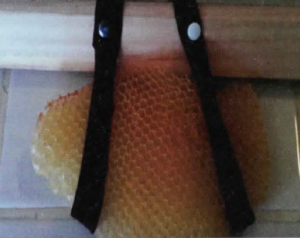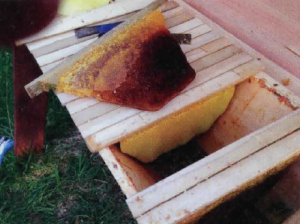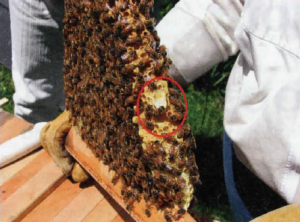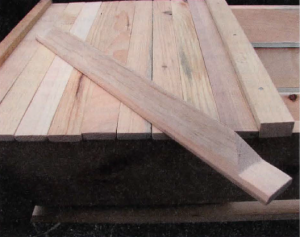By: Christy Hemenway
This article originally appeared in the Autumn 2016 issue of BEEKeeping Your First Three Years
Consider heat, rain and queen loss
The results of the 2015-16 Bee Informed Partnership annual survey are in. It hurts to think that beekeepers that responded to the survey lost 44% of their bees – and not only in Winter, but in Summer as well! We like to picture the Summer as a peaceful, healthy, idyllic time for bees, but the survey seems to give the lie to that. It’s unnerving that the jury remains out as to why that’s happening.
When it comes to Summer issues that affect your bees there are some things we DO know about and CAN work to prevent. So let’s put our focus on those things, shall we?
Summer issues that top bar hive beekeepers may encounter can be caused by:
- Heat
- Rain
- Queen loss
1) Heat. The most important feature of a top bar hive is what goes on inside – bees making natural beeswax comb. In a top bar hive that comb is attached by the bees to the comb guide on the bottom of the bar from which the hive derives its name. The attachment runs the length of the top bar, instead of being surrounded by a wooden frame and possibly even supported in the middle by wires or rigid plastic foundation.

Rehanging a piece of broken comb. Photo credit: Gold Star Honey Bees YouTube video: https://youtu.be/pdwxrByaqX0
But beeswax is exactly that – wax – and wax melts. Beeswax melts to liquid at about 145 degrees F, (63 degrees C). It gets quite soft at about 100 degrees F (38 degrees C). Depending on where you live, you could experience temperatures that high in your bee yard. This makes for some very soft and fragile comb.
So how do you inspect safely in the heat? As always, time and temperature matter a great deal to all things bee. If the temperature is too warm at 2pm in the afternoon, inspect earlier or later in the day – avoid the hottest part of the day and inspect when it’s a bit cooler.
Another option is to create some artificial shade at your hive. Lightweight popup tents are ideal for this – they make a noticeable difference for the beekeeper as well.
What do you do if a comb DOES break off the bar? Now you’re facing a couple of problems…First, you don’t want to give up the comb – at this time of year it is likely to be filled with eggs and larvae that are essential for the success of your hive. Second, the wax is very soft – as you have just been painfully reminded. This makes it tricky to “rehang” the comb because its weight is enough to thwart any attempts at sewing it back onto the bar. Another complication arises because you don’t want to change the spacing of the bars – so you don’t want to use anything to rehang a broken comb that forces the bars apart.

A typical top bar comb – Honey on top, pollen In the middle, and the darker comb at the bottom holds brood.
The best method we’ve found of fixing this problem is the “sling method.” To do this, you’ll need four flathead thumbtacks, and two strips of a slightly stretchy fabric (perhaps an old t-shirt) about ½” wide and long enough to reach from top to bottom of the comb twice and then a few inches more. Tack the ½” strips to the underside of your top bar. Space them apart enough so that they intersect the comb vertically into thirds. Lay the top bar on a work surface with the strips extending down and away from the bar. Place the piece of comb carefully on the fabric strips, then bring the end of the strips back up to the top bar. Tack them into place. Adjust things so that the comb hangs vertically below the bar, just as the bees built it. The sling supports the comb from below, and will hold the broken edge close to the bar where the bees can reattach it.
2) Rain. Rain in the summer is crucial. We understand that easily enough, right? Without enough rain the plants can’t bloom, and they can’t produce nectar and pollen – so the end result would be that there’s no food for your bees to forage for. That’s a real problem! But with too much rain – comes some problems of a different nature. Bees don’t do much flying in the rain – so they aren’t able to collect nectar to make honey, or pollen to feed baby bees. Even if they have their own honey stores, bees are so active in warm weather that they will consume those stores very quickly when they are cooped up inside the hive while it’s raining. It’s actually possible for bees to starve in the Summertime, due to an inability to forage during extended periods of rainy weather. Watch for this, and feed if needed – yes, even in the Summertime, and especially with new hives being started from packages.
Another way that rainy weather can affect your bees concerns the mating of queens. Since honey bees mate “on the wing” – if they can’t fly, they can’t mate. This spells disaster for bees that are in the process of swarming, and for the beekeeper that was unprepared for a swarm that has already flown. This beekeeper is now pinning their hopes on the new queen and the bees that stayed behind when the mated queen flew with the swarm. The optimal window of time for that queen bee to mate successfully is quite short – about 7 to 10 days. If it rains during that time frame – then the number of mating flights that she can take, and thus the number of drones that she can mate with, is diminished. This is another real problem! Promiscuity in the world of honey bees is a very good thing – you might say “the more the merrier.” Recent studies are showing that the bees are able to tell how “well-mated” the queen is, and that they show a distinct preference for “slutty” queens. The hive may attempt to supersede a queen bee that they don’t consider to have been well mated. She is not likely to be a good layer and also not likely to give off a strong queen pheromone. This can lead to a “failure to thrive” for the hive and lessen the cohesion and viability of the colony. Plus, fewer matings mean less diversity, and less chance for survival.
Rain is therefore a two-edged sword, whether too much or not enough. It’s definitely something that a beekeeper needs to be aware of in either case.
3) Queen-less-ness. Losing the queen bee is bad for your beehive. This is known. But one wonders what could possibly happen to a bee that doesn’t fly but a few times in her life. I mean, really – just how dangerous is it inside that beehive? The sobering answer is that much of the time, the cause of the queen’s demise or disappearance is the very beekeeper that most wants her to be happy and healthy. Inspections are important but they can also be risky.
There is a very real possibility that a beekeeper handling a frame or a top bar neglects to hold that comb over the hive while they are looking at it, and never notices the queen bee that falls off…and then gets crushed beneath their foot. It can also happen that the hive has built queen cells, in the course of preparing to swarm or to supersede their existing queen, but then during the course of an inspection the beekeeper accidentally crushes or tears open the queen cell.
So your hive is queen-less. Now what? Getting back to queen-right is your first concern, as this is crucial to your hive’s health and will also preclude a worker bee turning into a laying worker. If your hive has eggs or just hatched larvae, the bees can replace their queen on their own. They will take a tiny 3-day old larva and build the cell out to become a vertical queen cell. Then over the course of the next several weeks, they will be back in business with a queen of their own making. If your hive is without brood at this stage, but you have top bars that are interchangeable with another top bar beekeeper’s, and if they have bars with brood of the appropriate age, (if you ask nicely!) you may be able to arrange to acquire some brood in that way. The time factor can be important here – if your local growing season is very short, the time that elapses while the bees make a new queen and she flies to mate and then finally gets started laying, can be costly.
Another option is to purchase a mated queen bee. This will cause a complete changeover of the genetics of your hive – so be thoughtful about this process. If changing the genetics is your intent, you can purchase a new, mated queen that carries the genetics that you want and do this on purpose. Ten to twelve weeks after her arrival, you will have a hive filled with the new queen’s offspring. If you do not want to change the genetics, be sure to purchase a replacement queen with the same genetics as your original queen.
Interchangeable equipment matters when needing to support your bees in making queens. Something important to consider when choosing your top bar hive!











